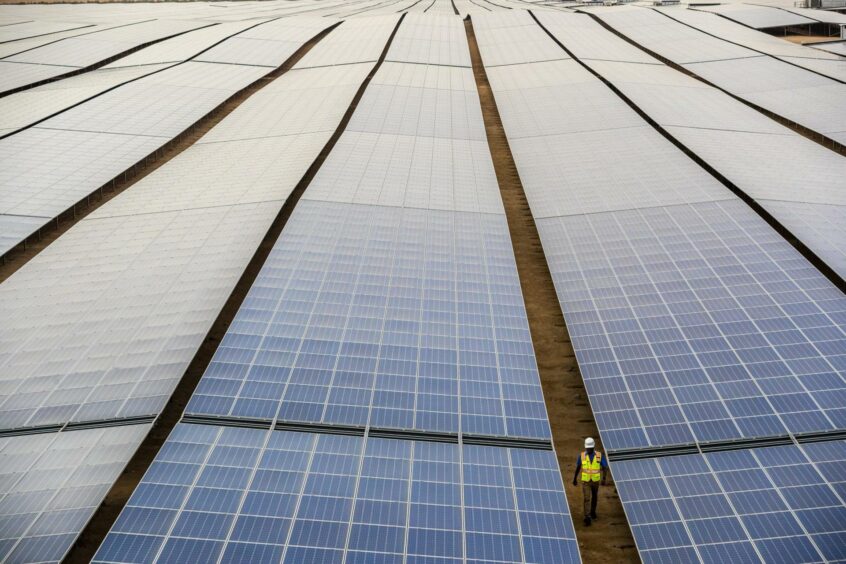
The Middle East’s oil and gas has put the region at the heart of the energy sector the last 100 years. These resources, plus plentiful sunshine, will see it continue to play a major role into the energy transition – but there will be bumps along the way.
Where Europe is looking to wind, and Africa to hydropower, solar is the clear winner in the Middle East.
In particular, solar photovoltaic (PV) is at the heart of the Middle East’s energy transition plans – and with good reason.
The trend over the last few years has been for bigger plants, at lower prices, in a large part driven by cheap Chinese manufacturing of panels.
In the five years to 2020, solar PV grew at a rate of 27% per year. The scale of the planned projects in the Middle East is extraordinary.
Dubai’s Mohammad bin Rashid Al Maktoum Solar Park aims to reach 5 GW of solar PV by 2030, the largest single solar project in the world.
A Masdar and EDF Renewables offered a bid of 2.99 US cents per kWh in 2016, the then record lowest price. Prices continued to fall, reaching a low of just over 1 cent per kWh.
Events of the last year, though, have undercut this trajectory. Logistics issues have thrown global supply chains into turmoil, not least as a result of Chinese lockdowns in order to control COVID-19 outbreaks.
The impact has been higher prices and shortages. Some projects that have been awarded are seeing the impact, let alone projects that have not yet reached that point.
Some contractors are working out how to extricate themselves from signed contracts. Careful consideration and calculation is looking at losing a bid bond versus how far under water a deal may be.
Given the numerous factors at play, and the inter connectedness of global links, there is no certainty as to when these problems will be resolved.
Considerations of energy security must take into account these new challenges. The response could only be a reliance on such old fashioned strategies such as long term contracts, locking in supply and prices for years, in a rejection of the “just in time” mentality that has allowed solar PV to flourish.
Masdar is one company that has been talking up such a move, in an apparent recognition that there are going to be no quick fixes.
Another technique would be the onshoring of manufacturing. If the solar PV modules can be produced locally, it would allow operators to cut out risks in the international supply chain. Such a move would provide local employment benefits but it does run the risk of higher prices.
A longstanding criticism of solar has been around the variability. At night, when the sun does not shine, solar supplies disappear from the grid. As solar projects expand to provide more and more power, this shift will become more marked.
For now, grid providers overcome this shortfall through the deployment of spinning reserves, often burning diesel.
The obvious solution would be battery storage, although progress on this front has been slow thus far. There are discussions around how best to accomplish such a shift, whether storage should be included in power tenders or whether a standalone tender is the best way.
Given the Middle East’s weather, there are practical challenges to the use of battery storage, although research is focused on tackling this problem. The economics would favour the continued use of hydrocarbons over battery storage, although states such as the United Arab Emirates have made net zero commitments.
Similar cost concerns pose challenges for hydrogen use. Producing hydrogen – whether from natural gas or solar – is an inefficient way to capture energy. The Middle East has substantial experience in the feedstock, but initially at least the focus is likely to be on exports, rather than domestic consumption.
Progress is coming. Where last year there may have been discussions around hydrogen, now companies are making plans and detailed engineering work is under way.
With governmental support, and regional expertise, there is no reason that the Middle East cannot come to command a leading role in supplying hydrogen to the world.
It is governmental drive that will have the clearest impact on the Middle East’s energy hopes and the model leading this trend is Saudi Arabia’s Neom.
The first stage of the plan involves 4 GW of renewable capacity, although the plan calls to scale this up to 40 GW. Neom will produce green hydrogen, which will be exported as green ammonia.
Bracewell and Energy Voice held their first NEO event in 2021, focused on the US market. This year, NEO 2 will turn a similar scrutiny to the Middle East. Register at Neo-2022.com and tune in on May 18 to hear Bracewell experts and others talk over the three topics of solar PV, hydrogen and battery storage.
Updated at 9:12 am to correct byline.